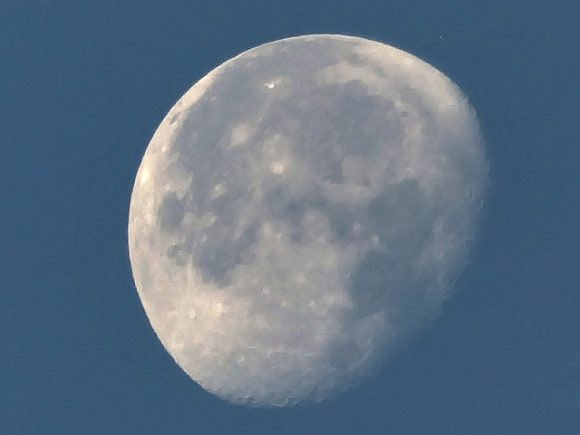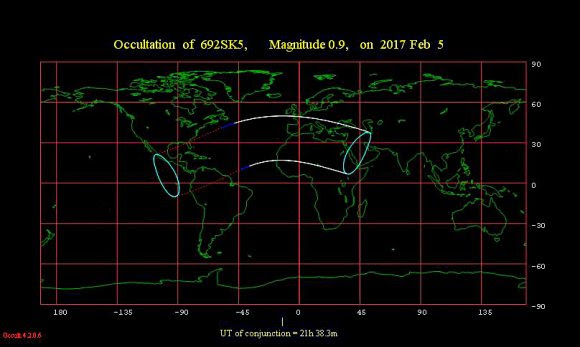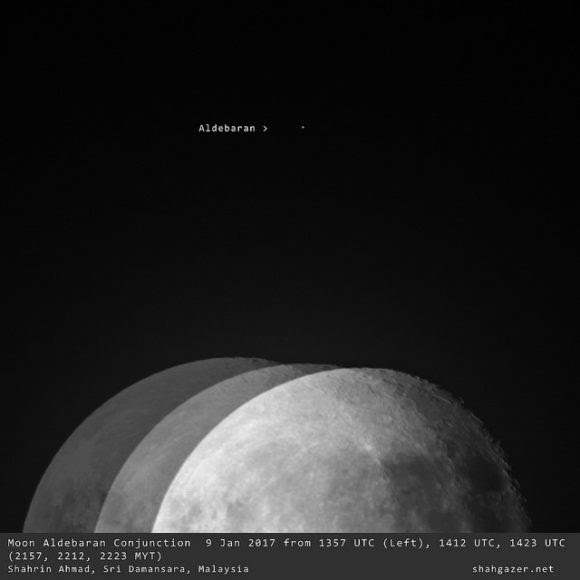
Can you see it? Dave Walker accidentally (!) caught Aldebaran near the daytime Moon on October 19th, 2016. Image credit and copyright: Dave Walker
Author's note: This Superbowl Sunday event and 101 more like it are featured in our latest free e-book, 101 Astronomical Events for 2017, out now from Universe Today.
Sure, this Superbowl Sunday brings with it the promise of sacks, fumbles and tackles... but have you ever seen the Moon run down a star in the end zone? Just such an event, referred to as an occultation, happens this weekend for folks living around the Mediterranean and — just maybe for some sharp-eyed, telescope-owning observers based around the Caribbean region — this coming weekend.
We're talking about Sunday's occultation of the bright star Aldebaran by the 64% illuminated waxing gibbous Moon. This is the 2nd occultation of Aldebaran by the Moon for 2017 and the 28th of the current ongoing cycle of 49 spanning from January 29th, 2015 to September 3rd, 2018. The Moon actually occults Aldebaran and Regulus once for every lunation in 2017. We won't have another year featuring the occultations of two +1st magnitude stars (Spica and Antares) again until 2024.

The footprint for the February 5th occultation of Aldebaran by the Moon. The broken lines show where the occultation occurs during daytime, and the solid lines denote where the occultation occurs under dark skies. Image credit: occult 4.2.
The event occurs under dark skies for observers based around the Mediterranean and under daytime afternoon skies for folks in central America, the Caribbean, northern South America and the Florida peninsula, including Astroguyz HQ based in Spring Hill, just north of the Tampa Bay area. We've managed to spy Aldebaran near the daytime Moon while the Sun was still above the horizon using binocs, and can attest that the +1st magnitude star is indeed visible, if you know exactly where to look for it.
Note that, like solar eclipses belonging to the same saros cycle, occultations of Aldebaran in the ongoing cycle drift north and westward from one to the next, to the tune of about 120 degrees longitude. Though most of North America sits this one out, we do get a front row seat for next lunation's occultation of Aldebaran on the evening of March 4/5th. The next one is the best bright star occultation of Aldebaran by the Moon for North America in 2017. And be sure to check out the Moon this Sunday evening after the big game, and note Aldebaran hanging just off of its bright limb.

No, the wind is not shaking the 'scope... Sharin Ahmad chronicled the motion of the Moon past Aldebaran from Kuala Lumpur, Malaysia last month. Image credit and copyright: Shahrin Ahmad (@shahgazer)
The ref will have a close call to make for this one. The northern grazeline in Florida might make this an especially interesting event to watch, though it'll be challenge, as the occultation occurs in the afternoon under daylight skies. This crosses right along near the cities of Jacksonville and Gainsville. Clear, deep blue high contrast skies are key, and we'll be watching from Astroguyz HQ north of Tampa Bay during this event.

The northern grazeline across the Florida peninsula for Sunday's 'big game'. Credit: Dave Dickinson.
Here are some key times from the occultation zone (noted in Universal Time):
Tampa, Florida
Ingress: 20:08 UT/Moon altitude: 23 degrees
Egress: 20:34 UT/Moon altitude: 29 degrees
Bogota, Columbia
Ingress: 19:34 UT/ Moon Altitude: 49 degrees
Egress: 20:29 UT/ Moon altitude: 31 degrees
Rome, Italy
Ingress: 20:21 UT/Moon altitude: 37 degrees
Egress: 23:12 UT/ Moon altitude: 28 degrees
Tel Aviv, Israel
Ingress: 22:39 UT/Moon altitude: 16 degrees
Egress: 23:29 UT/Moon altitude: 5 degrees
Casablanca, Morocco
Ingress: 21:49 UT/ Moon altitude: 61 degrees
Egress: 23:07 UT/ Moon altitude: 45 degrees
Note that this occultation spans five continents, a truly worldwide event. The International Occultation Timing Association (IOTA) maintains a page with an extensive list of times for cities worldwide. Note that when the Moon tackles Aldebaran, its also crossing the scrimmage line of the Hyades open cluster, so expect numerous occultations of fainter stars worldwide as well.
Aldebaran is the brightest star along the Moon's path in our current epoch, along with runner-ups Spica, Regulus and Antares. Though Aldebaran is 1.5 times the mass of our Sun, it's also 65 light years away, and only appears 20 milliarcseconds (mas) in size, about the equivalent of a 40 meter diameter crater from the distance of the Moon. Still, you might just notice a brief pause as Aldebaran fades then winks out on the dark limb of the Moon, a tiny hitch betraying its diminutive angular size.
And the clockwork gears of that biggest game of all, the Universe, grind on. Don't miss this first big ticket astronomical event for February 2017, coming to a sky above you. Next up, we'll watching out for another bright star occultation, two eclipses, and the close passage of a comet near the Earth.
Stay tuned!


No comments:
Post a Comment